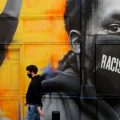COVID-19 Update: Face coverings and Smithsonian policy

With news of more-contagious variants of COVID-19 stateside and masks featuring prominently in media coverage, it is imperative we refresh our understanding of the Smithsonian’s protocols for face coverings. While face coverings are not a substitute for social distancing or staying home if you feel ill, they are a critical line of defense that protect our community.
We have learned a lot about their effectiveness, and what we said in the beginning remains true – face coverings work! Remember, no matter the style of face covering you wear, proper fit is key. Face coverings should fit snugly over your nose and securely under your chin and lay flat against your cheeks without any gaps. To learn more about how to choose, fit, and test face coverings, please watch this video.
Please take a moment to review the following updates and reminders and on this important topic.
Smithsonian policy: Smithsonian’s face covering policy for staff has been updated to improve clarity and to disallow single-layer masks. Face coverings are required in all common or shared work areas, inside or outside, including conference rooms, areas with open floorplans, and cubicle embankments. They should only be removed with permission from your supervisor or in certain circumstances including when eating or drinking, when you are alone in a room with a closed floor-to-ceiling door, or when you are working outside and assured you can practice social distancing.
Masks with exhalation valves are not permitted, nor are loose fitting items like bandanas, or single-layer gaiters. Face shields are not permitted on their own, but they may be worn over face coverings.
New Executive Orders: On January 20, President Biden signed Executive Order 13991 requiring the use of face coverings and social distancing in all Federal buildings and on Federal lands. A second mandate, Executive Order 13998, requires the use of face coverings on many domestic modes of transportation including in airports, and on planes, trains, boats, intercity busses, and all forms of public transportation. These Executive orders align with the Smithsonian’s policies and reinforce our commitment to the use of face coverings.
Double masking and multilayered face coverings: “Double masking” has recently received attention in the media. This approach involves wearing more than one face covering at a time. Double masking offers several benefits including increasing layers of protection, prolonging the life of a surgical mask or N-95 respirator, and helping ensure your mask properly fits close to your face. The Smithsonian does not require double masking but does require the use of multilayered face coverings. Please note, the face coverings that have been provided to on-site staff are multilayered.
Conserving N95 respirators: N95 respirators are critical personal protective equipment that must be conserved for health care workers and other medical first responders. At the Smithsonian, they are reserved for employees who must use them as part of their job responsibilities per a Job Hazard Analysis that includes proper fit testing and training.
Smithsonian scientists examine face covering materials: A few colleagues from Smithsonian’s Museum Conservation Institute, in partnership with NIST, have begun studyingthe effectiveness of certain face covering fabrics. To date, they found that cotton, especially cotton flannel, was the most effective at trapping microscopic particles that mimic exhaled droplets, which could contain the COVID-19 virus. Their work demonstrates that additional layers, as long as the face covering remains breathable, increases effectiveness. We’ll provide more details regarding this study on the COVID webpage in the future.
As stated by President Biden, “Put simply, masks and other public health measures reduce the spread of the disease, particularly when communities make widespread use of such measures, and thus save lives.” Do your part to keep your community safe. Follow Smithsonian’s safety guidelines at work and in your community.
Stay safe and be well,
COVID-19 Response Team
Posted: 5 February 2021
- Categories:






